Law for Business Managers: Contract and Employment Issues
VerifiedAdded on 2022/12/29
|12
|3604
|79
Report
AI Summary
This report delves into key aspects of business law, providing a comprehensive analysis of sole proprietorship, employment contracts, and dispute resolution. The first part explains the role of legal provisions in business organizations, focusing on sole proprietorship, partnerships, corporations, and LLCs. The second part addresses an employment contract scenario, advising Gemma on the process of dismissing an employee, Charanjit, and whether she is lawfully able to do so, considering the employee's poor performance and conduct. The report also outlines the legal requirements and procedures for terminating employment. The final part discusses dispute resolution, offering advice to resolve a dispute. The report covers express and implied terms of employment contracts and the rights of both employers and employees. This analysis is crucial for business managers to navigate legal frameworks and ensure compliance. The report also examines the key elements of an employment contract, including offer, acceptance, consideration, and intention. It provides a clear understanding of the legal landscape for businesses.
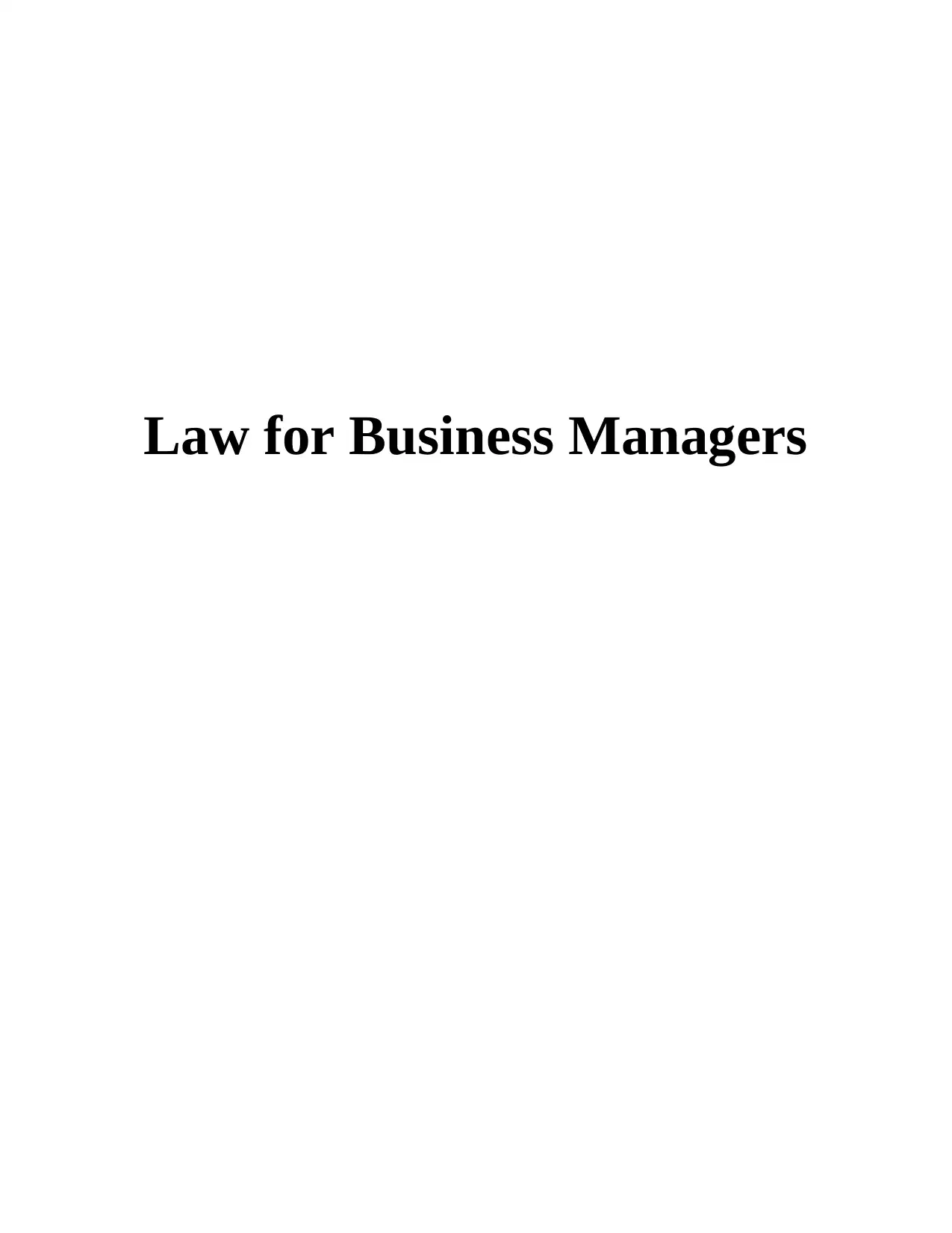
Law for Business Managers
Paraphrase This Document
Need a fresh take? Get an instant paraphrase of this document with our AI Paraphraser
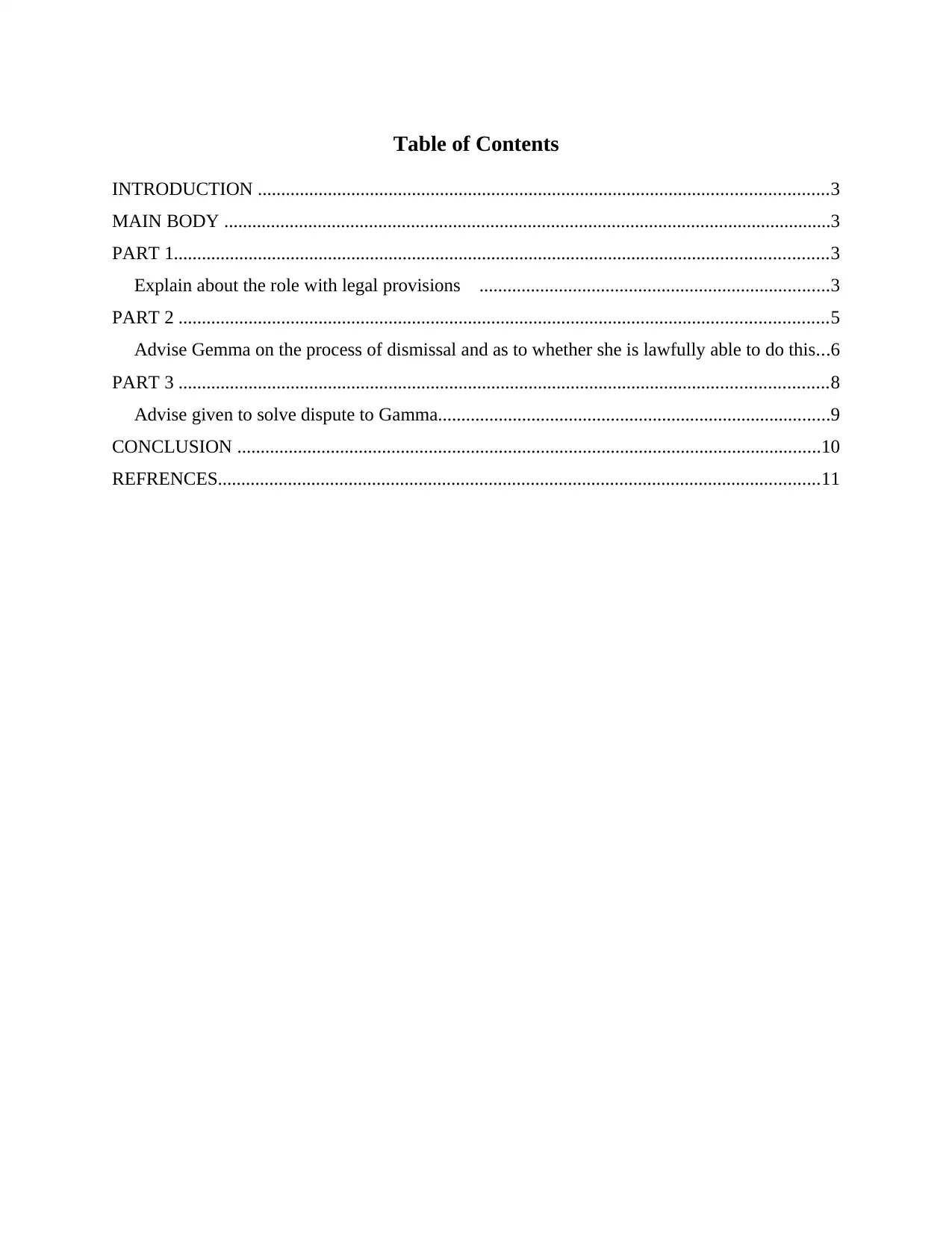
Table of Contents
INTRODUCTION ..........................................................................................................................3
MAIN BODY ..................................................................................................................................3
PART 1............................................................................................................................................3
Explain about the role with legal provisions ...........................................................................3
PART 2 ...........................................................................................................................................5
Advise Gemma on the process of dismissal and as to whether she is lawfully able to do this...6
PART 3 ...........................................................................................................................................8
Advise given to solve dispute to Gamma....................................................................................9
CONCLUSION .............................................................................................................................10
REFRENCES.................................................................................................................................11
INTRODUCTION ..........................................................................................................................3
MAIN BODY ..................................................................................................................................3
PART 1............................................................................................................................................3
Explain about the role with legal provisions ...........................................................................3
PART 2 ...........................................................................................................................................5
Advise Gemma on the process of dismissal and as to whether she is lawfully able to do this...6
PART 3 ...........................................................................................................................................8
Advise given to solve dispute to Gamma....................................................................................9
CONCLUSION .............................................................................................................................10
REFRENCES.................................................................................................................................11
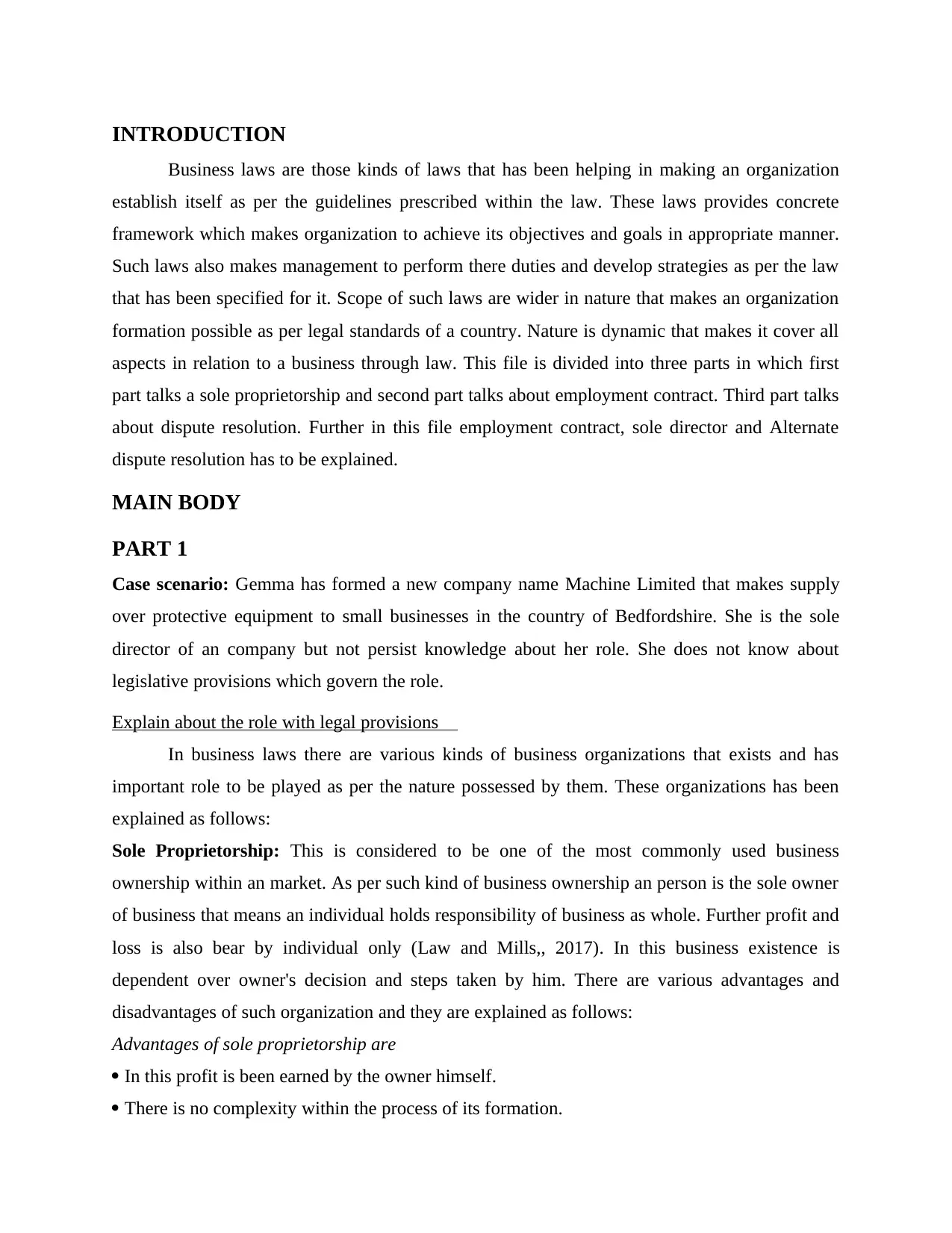
INTRODUCTION
Business laws are those kinds of laws that has been helping in making an organization
establish itself as per the guidelines prescribed within the law. These laws provides concrete
framework which makes organization to achieve its objectives and goals in appropriate manner.
Such laws also makes management to perform there duties and develop strategies as per the law
that has been specified for it. Scope of such laws are wider in nature that makes an organization
formation possible as per legal standards of a country. Nature is dynamic that makes it cover all
aspects in relation to a business through law. This file is divided into three parts in which first
part talks a sole proprietorship and second part talks about employment contract. Third part talks
about dispute resolution. Further in this file employment contract, sole director and Alternate
dispute resolution has to be explained.
MAIN BODY
PART 1
Case scenario: Gemma has formed a new company name Machine Limited that makes supply
over protective equipment to small businesses in the country of Bedfordshire. She is the sole
director of an company but not persist knowledge about her role. She does not know about
legislative provisions which govern the role.
Explain about the role with legal provisions
In business laws there are various kinds of business organizations that exists and has
important role to be played as per the nature possessed by them. These organizations has been
explained as follows:
Sole Proprietorship: This is considered to be one of the most commonly used business
ownership within an market. As per such kind of business ownership an person is the sole owner
of business that means an individual holds responsibility of business as whole. Further profit and
loss is also bear by individual only (Law and Mills,, 2017). In this business existence is
dependent over owner's decision and steps taken by him. There are various advantages and
disadvantages of such organization and they are explained as follows:
Advantages of sole proprietorship are
In this profit is been earned by the owner himself.
There is no complexity within the process of its formation.
Business laws are those kinds of laws that has been helping in making an organization
establish itself as per the guidelines prescribed within the law. These laws provides concrete
framework which makes organization to achieve its objectives and goals in appropriate manner.
Such laws also makes management to perform there duties and develop strategies as per the law
that has been specified for it. Scope of such laws are wider in nature that makes an organization
formation possible as per legal standards of a country. Nature is dynamic that makes it cover all
aspects in relation to a business through law. This file is divided into three parts in which first
part talks a sole proprietorship and second part talks about employment contract. Third part talks
about dispute resolution. Further in this file employment contract, sole director and Alternate
dispute resolution has to be explained.
MAIN BODY
PART 1
Case scenario: Gemma has formed a new company name Machine Limited that makes supply
over protective equipment to small businesses in the country of Bedfordshire. She is the sole
director of an company but not persist knowledge about her role. She does not know about
legislative provisions which govern the role.
Explain about the role with legal provisions
In business laws there are various kinds of business organizations that exists and has
important role to be played as per the nature possessed by them. These organizations has been
explained as follows:
Sole Proprietorship: This is considered to be one of the most commonly used business
ownership within an market. As per such kind of business ownership an person is the sole owner
of business that means an individual holds responsibility of business as whole. Further profit and
loss is also bear by individual only (Law and Mills,, 2017). In this business existence is
dependent over owner's decision and steps taken by him. There are various advantages and
disadvantages of such organization and they are explained as follows:
Advantages of sole proprietorship are
In this profit is been earned by the owner himself.
There is no complexity within the process of its formation.
⊘ This is a preview!⊘
Do you want full access?
Subscribe today to unlock all pages.

Trusted by 1+ million students worldwide
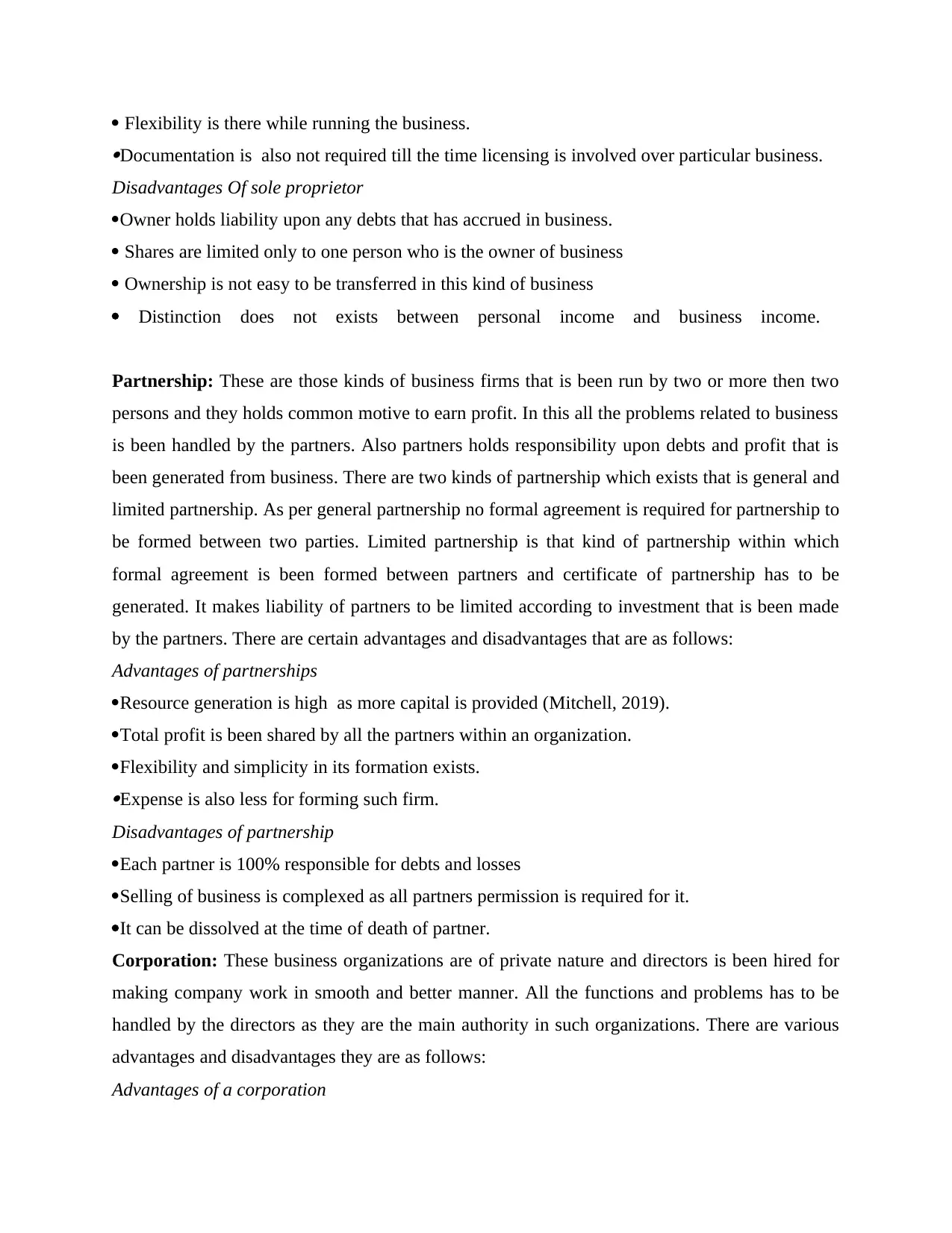
Flexibility is there while running the business.Documentation is also not required till the time licensing is involved over particular business.
Disadvantages Of sole proprietor
Owner holds liability upon any debts that has accrued in business.
Shares are limited only to one person who is the owner of business
Ownership is not easy to be transferred in this kind of business
Distinction does not exists between personal income and business income.
Partnership: These are those kinds of business firms that is been run by two or more then two
persons and they holds common motive to earn profit. In this all the problems related to business
is been handled by the partners. Also partners holds responsibility upon debts and profit that is
been generated from business. There are two kinds of partnership which exists that is general and
limited partnership. As per general partnership no formal agreement is required for partnership to
be formed between two parties. Limited partnership is that kind of partnership within which
formal agreement is been formed between partners and certificate of partnership has to be
generated. It makes liability of partners to be limited according to investment that is been made
by the partners. There are certain advantages and disadvantages that are as follows:
Advantages of partnerships
Resource generation is high as more capital is provided (Mitchell, 2019).
Total profit is been shared by all the partners within an organization.
Flexibility and simplicity in its formation exists.Expense is also less for forming such firm.
Disadvantages of partnership
Each partner is 100% responsible for debts and losses
Selling of business is complexed as all partners permission is required for it.
It can be dissolved at the time of death of partner.
Corporation: These business organizations are of private nature and directors is been hired for
making company work in smooth and better manner. All the functions and problems has to be
handled by the directors as they are the main authority in such organizations. There are various
advantages and disadvantages they are as follows:
Advantages of a corporation
Disadvantages Of sole proprietor
Owner holds liability upon any debts that has accrued in business.
Shares are limited only to one person who is the owner of business
Ownership is not easy to be transferred in this kind of business
Distinction does not exists between personal income and business income.
Partnership: These are those kinds of business firms that is been run by two or more then two
persons and they holds common motive to earn profit. In this all the problems related to business
is been handled by the partners. Also partners holds responsibility upon debts and profit that is
been generated from business. There are two kinds of partnership which exists that is general and
limited partnership. As per general partnership no formal agreement is required for partnership to
be formed between two parties. Limited partnership is that kind of partnership within which
formal agreement is been formed between partners and certificate of partnership has to be
generated. It makes liability of partners to be limited according to investment that is been made
by the partners. There are certain advantages and disadvantages that are as follows:
Advantages of partnerships
Resource generation is high as more capital is provided (Mitchell, 2019).
Total profit is been shared by all the partners within an organization.
Flexibility and simplicity in its formation exists.Expense is also less for forming such firm.
Disadvantages of partnership
Each partner is 100% responsible for debts and losses
Selling of business is complexed as all partners permission is required for it.
It can be dissolved at the time of death of partner.
Corporation: These business organizations are of private nature and directors is been hired for
making company work in smooth and better manner. All the functions and problems has to be
handled by the directors as they are the main authority in such organizations. There are various
advantages and disadvantages they are as follows:
Advantages of a corporation
Paraphrase This Document
Need a fresh take? Get an instant paraphrase of this document with our AI Paraphraser
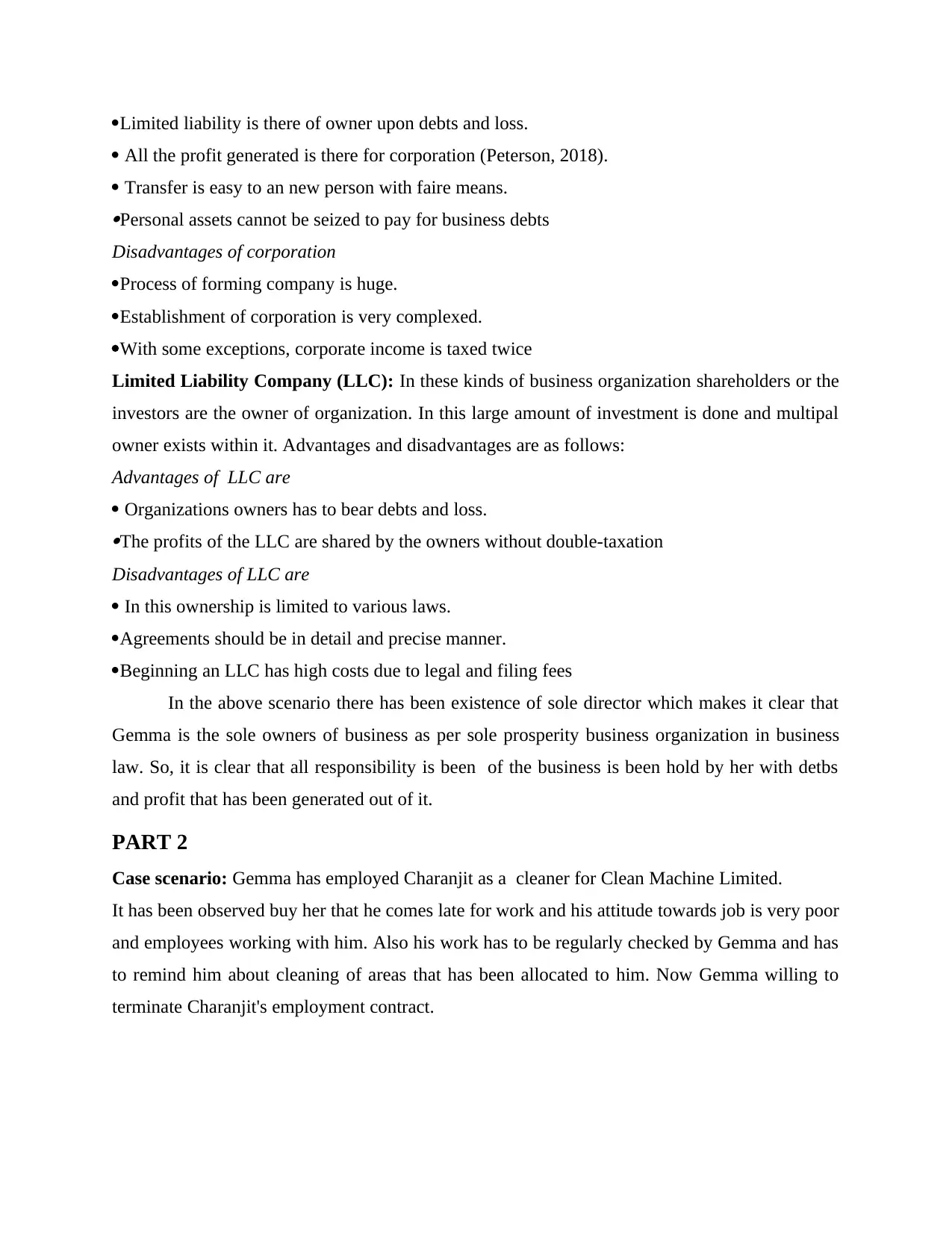
Limited liability is there of owner upon debts and loss.
All the profit generated is there for corporation (Peterson, 2018).
Transfer is easy to an new person with faire means.Personal assets cannot be seized to pay for business debts
Disadvantages of corporation
Process of forming company is huge.
Establishment of corporation is very complexed.
With some exceptions, corporate income is taxed twice
Limited Liability Company (LLC): In these kinds of business organization shareholders or the
investors are the owner of organization. In this large amount of investment is done and multipal
owner exists within it. Advantages and disadvantages are as follows:
Advantages of LLC are
Organizations owners has to bear debts and loss.The profits of the LLC are shared by the owners without double-taxation
Disadvantages of LLC are
In this ownership is limited to various laws.
Agreements should be in detail and precise manner.
Beginning an LLC has high costs due to legal and filing fees
In the above scenario there has been existence of sole director which makes it clear that
Gemma is the sole owners of business as per sole prosperity business organization in business
law. So, it is clear that all responsibility is been of the business is been hold by her with detbs
and profit that has been generated out of it.
PART 2
Case scenario: Gemma has employed Charanjit as a cleaner for Clean Machine Limited.
It has been observed buy her that he comes late for work and his attitude towards job is very poor
and employees working with him. Also his work has to be regularly checked by Gemma and has
to remind him about cleaning of areas that has been allocated to him. Now Gemma willing to
terminate Charanjit's employment contract.
All the profit generated is there for corporation (Peterson, 2018).
Transfer is easy to an new person with faire means.Personal assets cannot be seized to pay for business debts
Disadvantages of corporation
Process of forming company is huge.
Establishment of corporation is very complexed.
With some exceptions, corporate income is taxed twice
Limited Liability Company (LLC): In these kinds of business organization shareholders or the
investors are the owner of organization. In this large amount of investment is done and multipal
owner exists within it. Advantages and disadvantages are as follows:
Advantages of LLC are
Organizations owners has to bear debts and loss.The profits of the LLC are shared by the owners without double-taxation
Disadvantages of LLC are
In this ownership is limited to various laws.
Agreements should be in detail and precise manner.
Beginning an LLC has high costs due to legal and filing fees
In the above scenario there has been existence of sole director which makes it clear that
Gemma is the sole owners of business as per sole prosperity business organization in business
law. So, it is clear that all responsibility is been of the business is been hold by her with detbs
and profit that has been generated out of it.
PART 2
Case scenario: Gemma has employed Charanjit as a cleaner for Clean Machine Limited.
It has been observed buy her that he comes late for work and his attitude towards job is very poor
and employees working with him. Also his work has to be regularly checked by Gemma and has
to remind him about cleaning of areas that has been allocated to him. Now Gemma willing to
terminate Charanjit's employment contract.
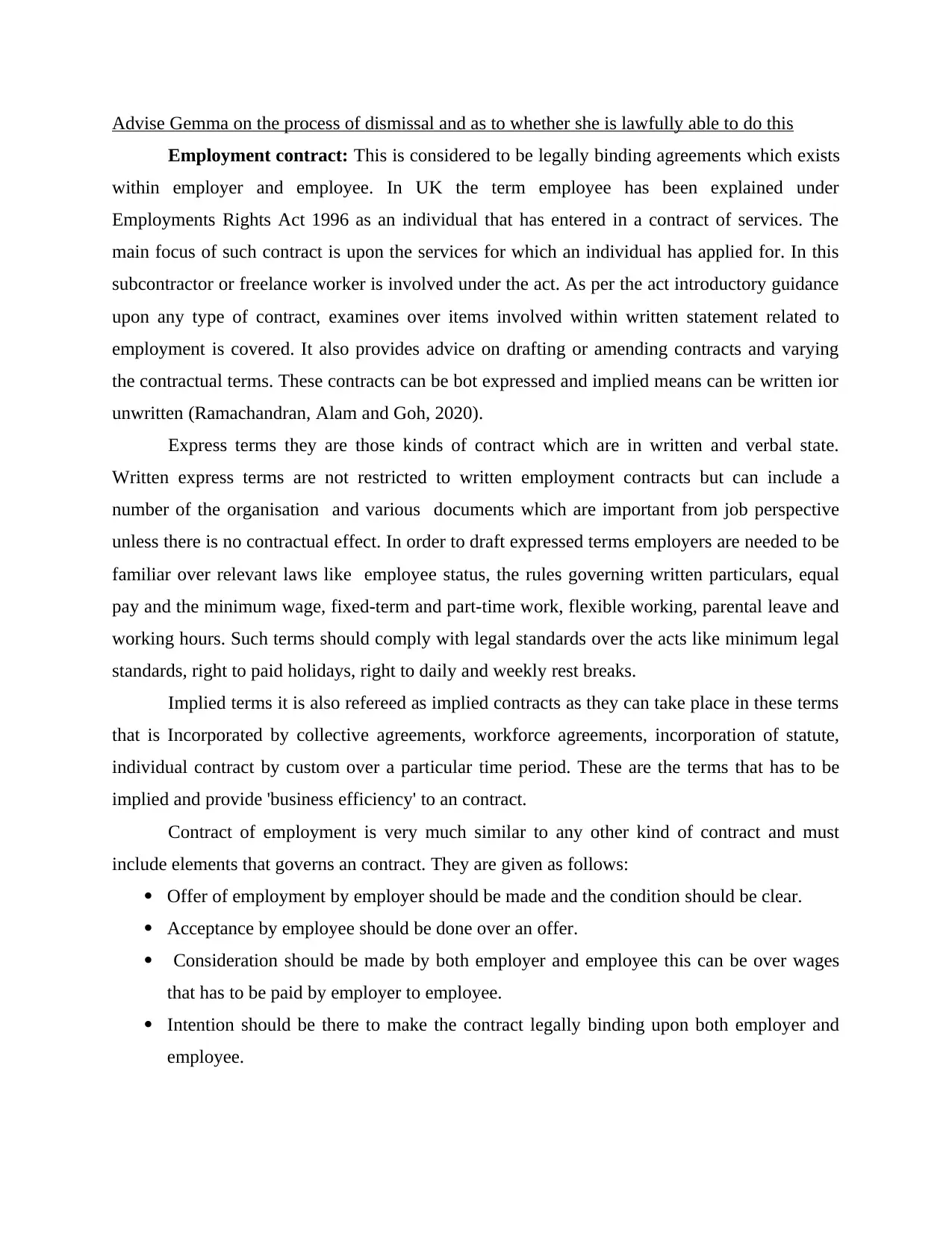
Advise Gemma on the process of dismissal and as to whether she is lawfully able to do this
Employment contract: This is considered to be legally binding agreements which exists
within employer and employee. In UK the term employee has been explained under
Employments Rights Act 1996 as an individual that has entered in a contract of services. The
main focus of such contract is upon the services for which an individual has applied for. In this
subcontractor or freelance worker is involved under the act. As per the act introductory guidance
upon any type of contract, examines over items involved within written statement related to
employment is covered. It also provides advice on drafting or amending contracts and varying
the contractual terms. These contracts can be bot expressed and implied means can be written ior
unwritten (Ramachandran, Alam and Goh, 2020).
Express terms they are those kinds of contract which are in written and verbal state.
Written express terms are not restricted to written employment contracts but can include a
number of the organisation and various documents which are important from job perspective
unless there is no contractual effect. In order to draft expressed terms employers are needed to be
familiar over relevant laws like employee status, the rules governing written particulars, equal
pay and the minimum wage, fixed-term and part-time work, flexible working, parental leave and
working hours. Such terms should comply with legal standards over the acts like minimum legal
standards, right to paid holidays, right to daily and weekly rest breaks.
Implied terms it is also refereed as implied contracts as they can take place in these terms
that is Incorporated by collective agreements, workforce agreements, incorporation of statute,
individual contract by custom over a particular time period. These are the terms that has to be
implied and provide 'business efficiency' to an contract.
Contract of employment is very much similar to any other kind of contract and must
include elements that governs an contract. They are given as follows:
Offer of employment by employer should be made and the condition should be clear.
Acceptance by employee should be done over an offer.
Consideration should be made by both employer and employee this can be over wages
that has to be paid by employer to employee.
Intention should be there to make the contract legally binding upon both employer and
employee.
Employment contract: This is considered to be legally binding agreements which exists
within employer and employee. In UK the term employee has been explained under
Employments Rights Act 1996 as an individual that has entered in a contract of services. The
main focus of such contract is upon the services for which an individual has applied for. In this
subcontractor or freelance worker is involved under the act. As per the act introductory guidance
upon any type of contract, examines over items involved within written statement related to
employment is covered. It also provides advice on drafting or amending contracts and varying
the contractual terms. These contracts can be bot expressed and implied means can be written ior
unwritten (Ramachandran, Alam and Goh, 2020).
Express terms they are those kinds of contract which are in written and verbal state.
Written express terms are not restricted to written employment contracts but can include a
number of the organisation and various documents which are important from job perspective
unless there is no contractual effect. In order to draft expressed terms employers are needed to be
familiar over relevant laws like employee status, the rules governing written particulars, equal
pay and the minimum wage, fixed-term and part-time work, flexible working, parental leave and
working hours. Such terms should comply with legal standards over the acts like minimum legal
standards, right to paid holidays, right to daily and weekly rest breaks.
Implied terms it is also refereed as implied contracts as they can take place in these terms
that is Incorporated by collective agreements, workforce agreements, incorporation of statute,
individual contract by custom over a particular time period. These are the terms that has to be
implied and provide 'business efficiency' to an contract.
Contract of employment is very much similar to any other kind of contract and must
include elements that governs an contract. They are given as follows:
Offer of employment by employer should be made and the condition should be clear.
Acceptance by employee should be done over an offer.
Consideration should be made by both employer and employee this can be over wages
that has to be paid by employer to employee.
Intention should be there to make the contract legally binding upon both employer and
employee.
⊘ This is a preview!⊘
Do you want full access?
Subscribe today to unlock all pages.

Trusted by 1+ million students worldwide
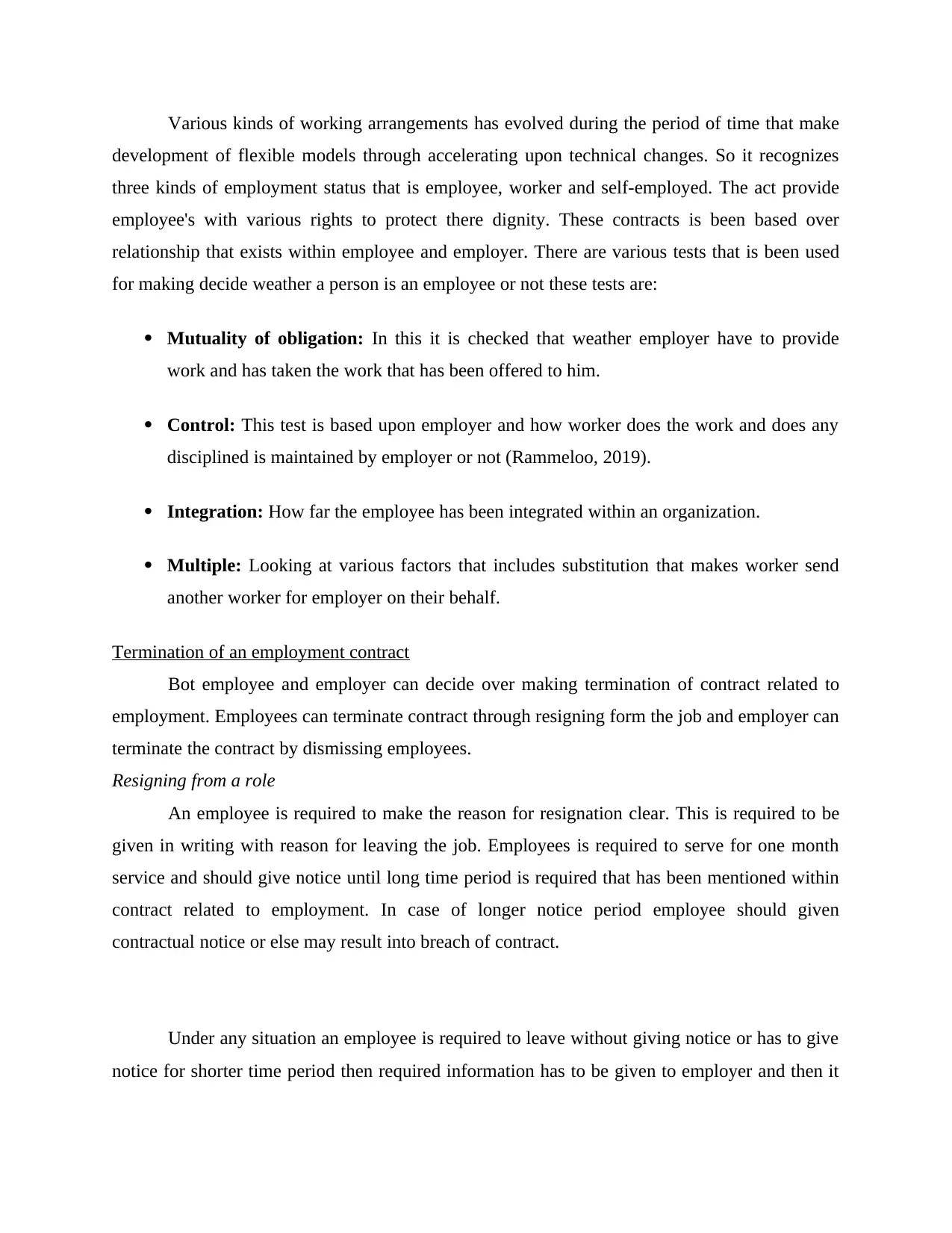
Various kinds of working arrangements has evolved during the period of time that make
development of flexible models through accelerating upon technical changes. So it recognizes
three kinds of employment status that is employee, worker and self-employed. The act provide
employee's with various rights to protect there dignity. These contracts is been based over
relationship that exists within employee and employer. There are various tests that is been used
for making decide weather a person is an employee or not these tests are:
Mutuality of obligation: In this it is checked that weather employer have to provide
work and has taken the work that has been offered to him.
Control: This test is based upon employer and how worker does the work and does any
disciplined is maintained by employer or not (Rammeloo, 2019).
Integration: How far the employee has been integrated within an organization.
Multiple: Looking at various factors that includes substitution that makes worker send
another worker for employer on their behalf.
Termination of an employment contract
Bot employee and employer can decide over making termination of contract related to
employment. Employees can terminate contract through resigning form the job and employer can
terminate the contract by dismissing employees.
Resigning from a role
An employee is required to make the reason for resignation clear. This is required to be
given in writing with reason for leaving the job. Employees is required to serve for one month
service and should give notice until long time period is required that has been mentioned within
contract related to employment. In case of longer notice period employee should given
contractual notice or else may result into breach of contract.
Under any situation an employee is required to leave without giving notice or has to give
notice for shorter time period then required information has to be given to employer and then it
development of flexible models through accelerating upon technical changes. So it recognizes
three kinds of employment status that is employee, worker and self-employed. The act provide
employee's with various rights to protect there dignity. These contracts is been based over
relationship that exists within employee and employer. There are various tests that is been used
for making decide weather a person is an employee or not these tests are:
Mutuality of obligation: In this it is checked that weather employer have to provide
work and has taken the work that has been offered to him.
Control: This test is based upon employer and how worker does the work and does any
disciplined is maintained by employer or not (Rammeloo, 2019).
Integration: How far the employee has been integrated within an organization.
Multiple: Looking at various factors that includes substitution that makes worker send
another worker for employer on their behalf.
Termination of an employment contract
Bot employee and employer can decide over making termination of contract related to
employment. Employees can terminate contract through resigning form the job and employer can
terminate the contract by dismissing employees.
Resigning from a role
An employee is required to make the reason for resignation clear. This is required to be
given in writing with reason for leaving the job. Employees is required to serve for one month
service and should give notice until long time period is required that has been mentioned within
contract related to employment. In case of longer notice period employee should given
contractual notice or else may result into breach of contract.
Under any situation an employee is required to leave without giving notice or has to give
notice for shorter time period then required information has to be given to employer and then it
Paraphrase This Document
Need a fresh take? Get an instant paraphrase of this document with our AI Paraphraser
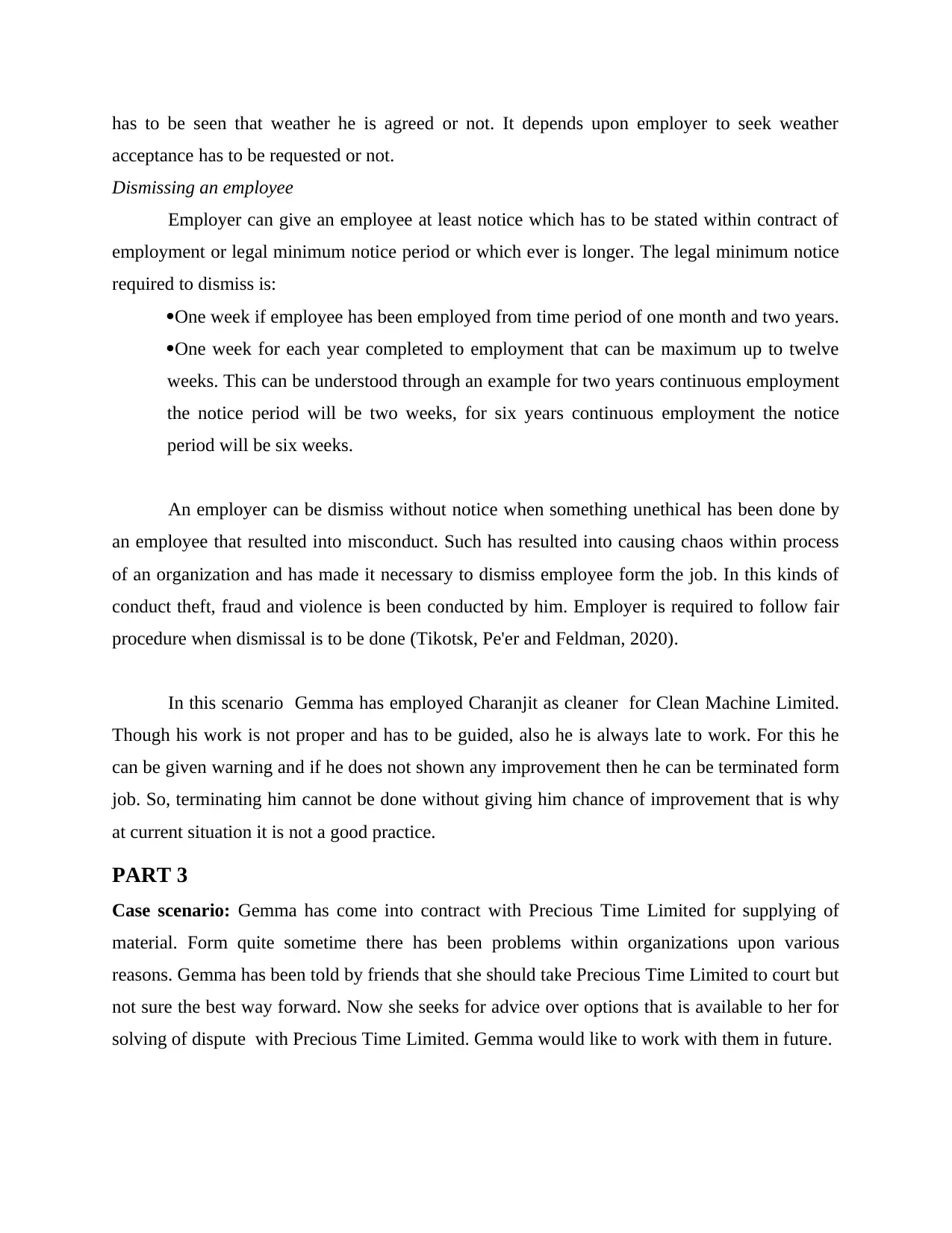
has to be seen that weather he is agreed or not. It depends upon employer to seek weather
acceptance has to be requested or not.
Dismissing an employee
Employer can give an employee at least notice which has to be stated within contract of
employment or legal minimum notice period or which ever is longer. The legal minimum notice
required to dismiss is:
One week if employee has been employed from time period of one month and two years.
One week for each year completed to employment that can be maximum up to twelve
weeks. This can be understood through an example for two years continuous employment
the notice period will be two weeks, for six years continuous employment the notice
period will be six weeks.
An employer can be dismiss without notice when something unethical has been done by
an employee that resulted into misconduct. Such has resulted into causing chaos within process
of an organization and has made it necessary to dismiss employee form the job. In this kinds of
conduct theft, fraud and violence is been conducted by him. Employer is required to follow fair
procedure when dismissal is to be done (Tikotsk, Pe'er and Feldman, 2020).
In this scenario Gemma has employed Charanjit as cleaner for Clean Machine Limited.
Though his work is not proper and has to be guided, also he is always late to work. For this he
can be given warning and if he does not shown any improvement then he can be terminated form
job. So, terminating him cannot be done without giving him chance of improvement that is why
at current situation it is not a good practice.
PART 3
Case scenario: Gemma has come into contract with Precious Time Limited for supplying of
material. Form quite sometime there has been problems within organizations upon various
reasons. Gemma has been told by friends that she should take Precious Time Limited to court but
not sure the best way forward. Now she seeks for advice over options that is available to her for
solving of dispute with Precious Time Limited. Gemma would like to work with them in future.
acceptance has to be requested or not.
Dismissing an employee
Employer can give an employee at least notice which has to be stated within contract of
employment or legal minimum notice period or which ever is longer. The legal minimum notice
required to dismiss is:
One week if employee has been employed from time period of one month and two years.
One week for each year completed to employment that can be maximum up to twelve
weeks. This can be understood through an example for two years continuous employment
the notice period will be two weeks, for six years continuous employment the notice
period will be six weeks.
An employer can be dismiss without notice when something unethical has been done by
an employee that resulted into misconduct. Such has resulted into causing chaos within process
of an organization and has made it necessary to dismiss employee form the job. In this kinds of
conduct theft, fraud and violence is been conducted by him. Employer is required to follow fair
procedure when dismissal is to be done (Tikotsk, Pe'er and Feldman, 2020).
In this scenario Gemma has employed Charanjit as cleaner for Clean Machine Limited.
Though his work is not proper and has to be guided, also he is always late to work. For this he
can be given warning and if he does not shown any improvement then he can be terminated form
job. So, terminating him cannot be done without giving him chance of improvement that is why
at current situation it is not a good practice.
PART 3
Case scenario: Gemma has come into contract with Precious Time Limited for supplying of
material. Form quite sometime there has been problems within organizations upon various
reasons. Gemma has been told by friends that she should take Precious Time Limited to court but
not sure the best way forward. Now she seeks for advice over options that is available to her for
solving of dispute with Precious Time Limited. Gemma would like to work with them in future.
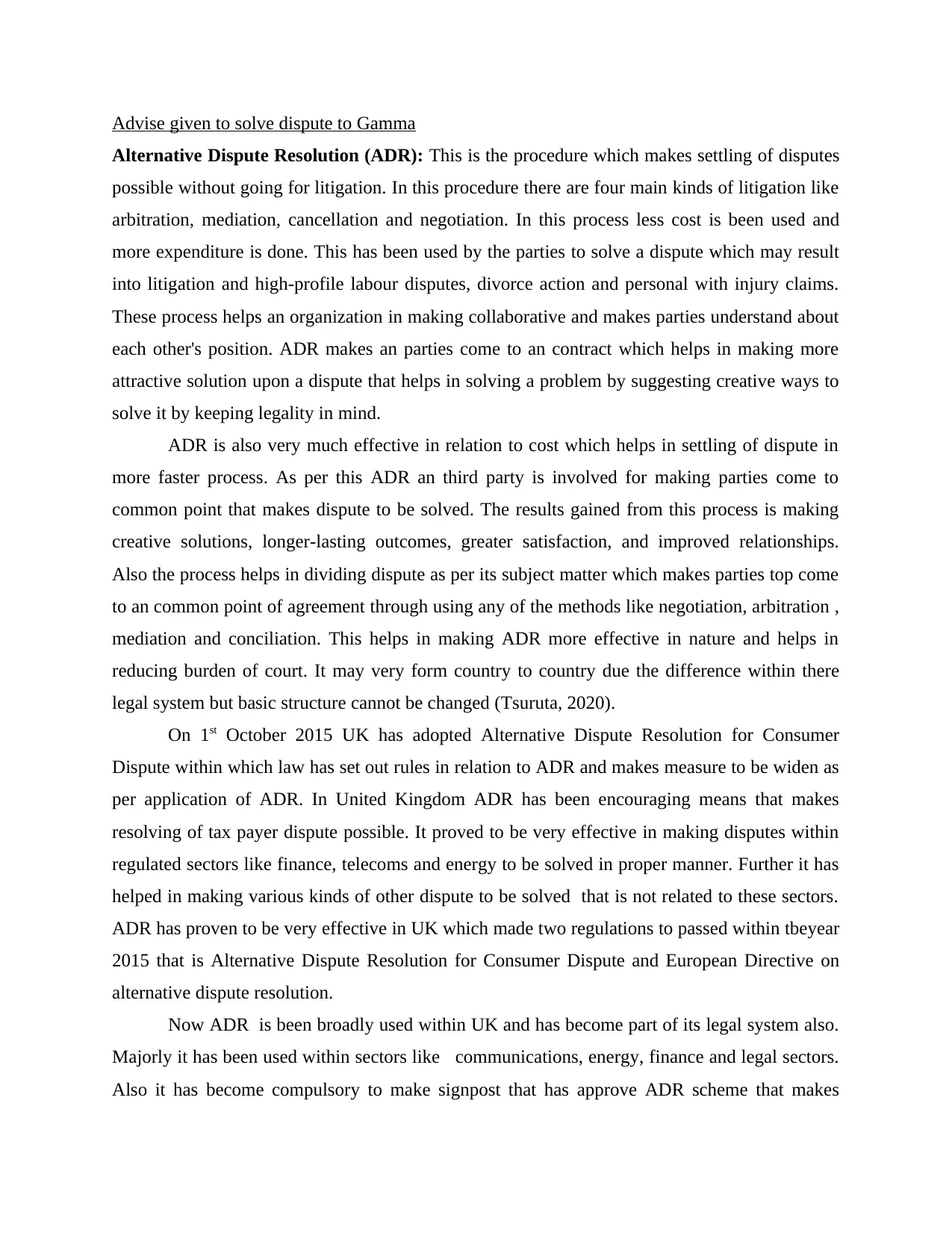
Advise given to solve dispute to Gamma
Alternative Dispute Resolution (ADR): This is the procedure which makes settling of disputes
possible without going for litigation. In this procedure there are four main kinds of litigation like
arbitration, mediation, cancellation and negotiation. In this process less cost is been used and
more expenditure is done. This has been used by the parties to solve a dispute which may result
into litigation and high-profile labour disputes, divorce action and personal with injury claims.
These process helps an organization in making collaborative and makes parties understand about
each other's position. ADR makes an parties come to an contract which helps in making more
attractive solution upon a dispute that helps in solving a problem by suggesting creative ways to
solve it by keeping legality in mind.
ADR is also very much effective in relation to cost which helps in settling of dispute in
more faster process. As per this ADR an third party is involved for making parties come to
common point that makes dispute to be solved. The results gained from this process is making
creative solutions, longer-lasting outcomes, greater satisfaction, and improved relationships.
Also the process helps in dividing dispute as per its subject matter which makes parties top come
to an common point of agreement through using any of the methods like negotiation, arbitration ,
mediation and conciliation. This helps in making ADR more effective in nature and helps in
reducing burden of court. It may very form country to country due the difference within there
legal system but basic structure cannot be changed (Tsuruta, 2020).
On 1st October 2015 UK has adopted Alternative Dispute Resolution for Consumer
Dispute within which law has set out rules in relation to ADR and makes measure to be widen as
per application of ADR. In United Kingdom ADR has been encouraging means that makes
resolving of tax payer dispute possible. It proved to be very effective in making disputes within
regulated sectors like finance, telecoms and energy to be solved in proper manner. Further it has
helped in making various kinds of other dispute to be solved that is not related to these sectors.
ADR has proven to be very effective in UK which made two regulations to passed within tbeyear
2015 that is Alternative Dispute Resolution for Consumer Dispute and European Directive on
alternative dispute resolution.
Now ADR is been broadly used within UK and has become part of its legal system also.
Majorly it has been used within sectors like communications, energy, finance and legal sectors.
Also it has become compulsory to make signpost that has approve ADR scheme that makes
Alternative Dispute Resolution (ADR): This is the procedure which makes settling of disputes
possible without going for litigation. In this procedure there are four main kinds of litigation like
arbitration, mediation, cancellation and negotiation. In this process less cost is been used and
more expenditure is done. This has been used by the parties to solve a dispute which may result
into litigation and high-profile labour disputes, divorce action and personal with injury claims.
These process helps an organization in making collaborative and makes parties understand about
each other's position. ADR makes an parties come to an contract which helps in making more
attractive solution upon a dispute that helps in solving a problem by suggesting creative ways to
solve it by keeping legality in mind.
ADR is also very much effective in relation to cost which helps in settling of dispute in
more faster process. As per this ADR an third party is involved for making parties come to
common point that makes dispute to be solved. The results gained from this process is making
creative solutions, longer-lasting outcomes, greater satisfaction, and improved relationships.
Also the process helps in dividing dispute as per its subject matter which makes parties top come
to an common point of agreement through using any of the methods like negotiation, arbitration ,
mediation and conciliation. This helps in making ADR more effective in nature and helps in
reducing burden of court. It may very form country to country due the difference within there
legal system but basic structure cannot be changed (Tsuruta, 2020).
On 1st October 2015 UK has adopted Alternative Dispute Resolution for Consumer
Dispute within which law has set out rules in relation to ADR and makes measure to be widen as
per application of ADR. In United Kingdom ADR has been encouraging means that makes
resolving of tax payer dispute possible. It proved to be very effective in making disputes within
regulated sectors like finance, telecoms and energy to be solved in proper manner. Further it has
helped in making various kinds of other dispute to be solved that is not related to these sectors.
ADR has proven to be very effective in UK which made two regulations to passed within tbeyear
2015 that is Alternative Dispute Resolution for Consumer Dispute and European Directive on
alternative dispute resolution.
Now ADR is been broadly used within UK and has become part of its legal system also.
Majorly it has been used within sectors like communications, energy, finance and legal sectors.
Also it has become compulsory to make signpost that has approve ADR scheme that makes
⊘ This is a preview!⊘
Do you want full access?
Subscribe today to unlock all pages.

Trusted by 1+ million students worldwide
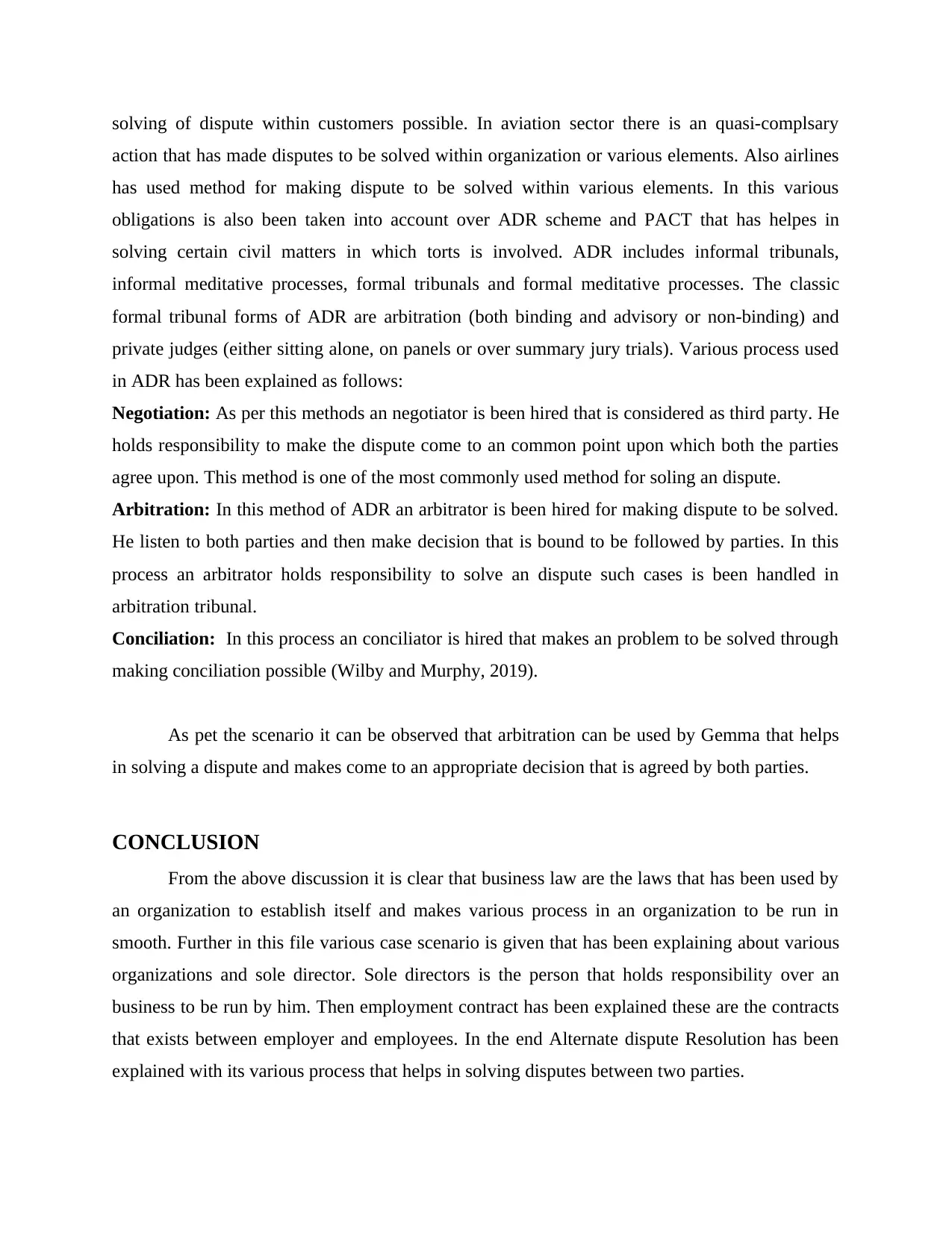
solving of dispute within customers possible. In aviation sector there is an quasi-complsary
action that has made disputes to be solved within organization or various elements. Also airlines
has used method for making dispute to be solved within various elements. In this various
obligations is also been taken into account over ADR scheme and PACT that has helpes in
solving certain civil matters in which torts is involved. ADR includes informal tribunals,
informal meditative processes, formal tribunals and formal meditative processes. The classic
formal tribunal forms of ADR are arbitration (both binding and advisory or non-binding) and
private judges (either sitting alone, on panels or over summary jury trials). Various process used
in ADR has been explained as follows:
Negotiation: As per this methods an negotiator is been hired that is considered as third party. He
holds responsibility to make the dispute come to an common point upon which both the parties
agree upon. This method is one of the most commonly used method for soling an dispute.
Arbitration: In this method of ADR an arbitrator is been hired for making dispute to be solved.
He listen to both parties and then make decision that is bound to be followed by parties. In this
process an arbitrator holds responsibility to solve an dispute such cases is been handled in
arbitration tribunal.
Conciliation: In this process an conciliator is hired that makes an problem to be solved through
making conciliation possible (Wilby and Murphy, 2019).
As pet the scenario it can be observed that arbitration can be used by Gemma that helps
in solving a dispute and makes come to an appropriate decision that is agreed by both parties.
CONCLUSION
From the above discussion it is clear that business law are the laws that has been used by
an organization to establish itself and makes various process in an organization to be run in
smooth. Further in this file various case scenario is given that has been explaining about various
organizations and sole director. Sole directors is the person that holds responsibility over an
business to be run by him. Then employment contract has been explained these are the contracts
that exists between employer and employees. In the end Alternate dispute Resolution has been
explained with its various process that helps in solving disputes between two parties.
action that has made disputes to be solved within organization or various elements. Also airlines
has used method for making dispute to be solved within various elements. In this various
obligations is also been taken into account over ADR scheme and PACT that has helpes in
solving certain civil matters in which torts is involved. ADR includes informal tribunals,
informal meditative processes, formal tribunals and formal meditative processes. The classic
formal tribunal forms of ADR are arbitration (both binding and advisory or non-binding) and
private judges (either sitting alone, on panels or over summary jury trials). Various process used
in ADR has been explained as follows:
Negotiation: As per this methods an negotiator is been hired that is considered as third party. He
holds responsibility to make the dispute come to an common point upon which both the parties
agree upon. This method is one of the most commonly used method for soling an dispute.
Arbitration: In this method of ADR an arbitrator is been hired for making dispute to be solved.
He listen to both parties and then make decision that is bound to be followed by parties. In this
process an arbitrator holds responsibility to solve an dispute such cases is been handled in
arbitration tribunal.
Conciliation: In this process an conciliator is hired that makes an problem to be solved through
making conciliation possible (Wilby and Murphy, 2019).
As pet the scenario it can be observed that arbitration can be used by Gemma that helps
in solving a dispute and makes come to an appropriate decision that is agreed by both parties.
CONCLUSION
From the above discussion it is clear that business law are the laws that has been used by
an organization to establish itself and makes various process in an organization to be run in
smooth. Further in this file various case scenario is given that has been explaining about various
organizations and sole director. Sole directors is the person that holds responsibility over an
business to be run by him. Then employment contract has been explained these are the contracts
that exists between employer and employees. In the end Alternate dispute Resolution has been
explained with its various process that helps in solving disputes between two parties.
Paraphrase This Document
Need a fresh take? Get an instant paraphrase of this document with our AI Paraphraser
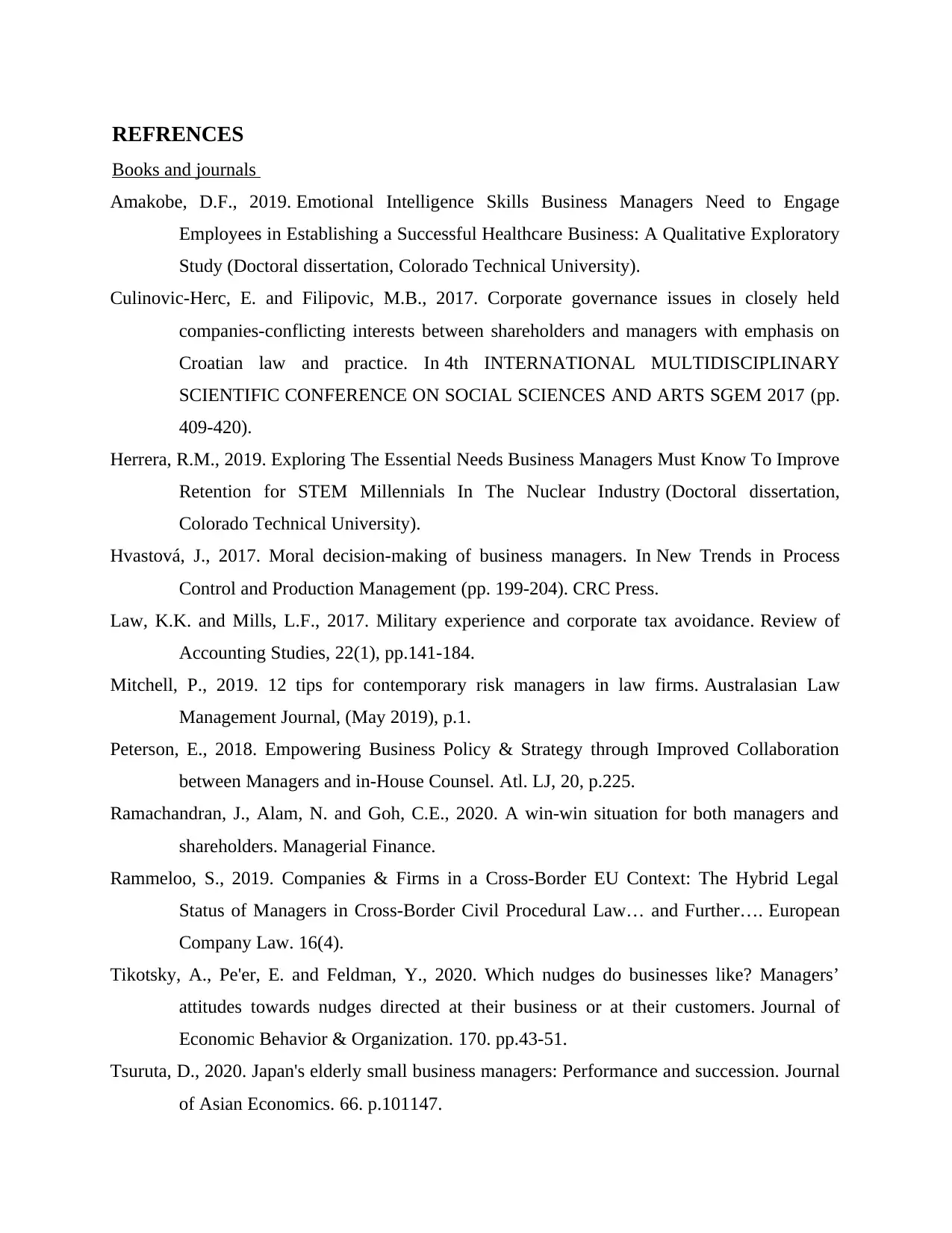
REFRENCES
Books and journals
Amakobe, D.F., 2019. Emotional Intelligence Skills Business Managers Need to Engage
Employees in Establishing a Successful Healthcare Business: A Qualitative Exploratory
Study (Doctoral dissertation, Colorado Technical University).
Culinovic-Herc, E. and Filipovic, M.B., 2017. Corporate governance issues in closely held
companies-conflicting interests between shareholders and managers with emphasis on
Croatian law and practice. In 4th INTERNATIONAL MULTIDISCIPLINARY
SCIENTIFIC CONFERENCE ON SOCIAL SCIENCES AND ARTS SGEM 2017 (pp.
409-420).
Herrera, R.M., 2019. Exploring The Essential Needs Business Managers Must Know To Improve
Retention for STEM Millennials In The Nuclear Industry (Doctoral dissertation,
Colorado Technical University).
Hvastová, J., 2017. Moral decision-making of business managers. In New Trends in Process
Control and Production Management (pp. 199-204). CRC Press.
Law, K.K. and Mills, L.F., 2017. Military experience and corporate tax avoidance. Review of
Accounting Studies, 22(1), pp.141-184.
Mitchell, P., 2019. 12 tips for contemporary risk managers in law firms. Australasian Law
Management Journal, (May 2019), p.1.
Peterson, E., 2018. Empowering Business Policy & Strategy through Improved Collaboration
between Managers and in-House Counsel. Atl. LJ, 20, p.225.
Ramachandran, J., Alam, N. and Goh, C.E., 2020. A win-win situation for both managers and
shareholders. Managerial Finance.
Rammeloo, S., 2019. Companies & Firms in a Cross-Border EU Context: The Hybrid Legal
Status of Managers in Cross-Border Civil Procedural Law… and Further…. European
Company Law. 16(4).
Tikotsky, A., Pe'er, E. and Feldman, Y., 2020. Which nudges do businesses like? Managers’
attitudes towards nudges directed at their business or at their customers. Journal of
Economic Behavior & Organization. 170. pp.43-51.
Tsuruta, D., 2020. Japan's elderly small business managers: Performance and succession. Journal
of Asian Economics. 66. p.101147.
Books and journals
Amakobe, D.F., 2019. Emotional Intelligence Skills Business Managers Need to Engage
Employees in Establishing a Successful Healthcare Business: A Qualitative Exploratory
Study (Doctoral dissertation, Colorado Technical University).
Culinovic-Herc, E. and Filipovic, M.B., 2017. Corporate governance issues in closely held
companies-conflicting interests between shareholders and managers with emphasis on
Croatian law and practice. In 4th INTERNATIONAL MULTIDISCIPLINARY
SCIENTIFIC CONFERENCE ON SOCIAL SCIENCES AND ARTS SGEM 2017 (pp.
409-420).
Herrera, R.M., 2019. Exploring The Essential Needs Business Managers Must Know To Improve
Retention for STEM Millennials In The Nuclear Industry (Doctoral dissertation,
Colorado Technical University).
Hvastová, J., 2017. Moral decision-making of business managers. In New Trends in Process
Control and Production Management (pp. 199-204). CRC Press.
Law, K.K. and Mills, L.F., 2017. Military experience and corporate tax avoidance. Review of
Accounting Studies, 22(1), pp.141-184.
Mitchell, P., 2019. 12 tips for contemporary risk managers in law firms. Australasian Law
Management Journal, (May 2019), p.1.
Peterson, E., 2018. Empowering Business Policy & Strategy through Improved Collaboration
between Managers and in-House Counsel. Atl. LJ, 20, p.225.
Ramachandran, J., Alam, N. and Goh, C.E., 2020. A win-win situation for both managers and
shareholders. Managerial Finance.
Rammeloo, S., 2019. Companies & Firms in a Cross-Border EU Context: The Hybrid Legal
Status of Managers in Cross-Border Civil Procedural Law… and Further…. European
Company Law. 16(4).
Tikotsky, A., Pe'er, E. and Feldman, Y., 2020. Which nudges do businesses like? Managers’
attitudes towards nudges directed at their business or at their customers. Journal of
Economic Behavior & Organization. 170. pp.43-51.
Tsuruta, D., 2020. Japan's elderly small business managers: Performance and succession. Journal
of Asian Economics. 66. p.101147.

Wilby, R. and Murphy, C., 2019. Decision-making by water managers despite climate
uncertainty. In The Oxford Handbook of Planning for Climate Change Hazards.
uncertainty. In The Oxford Handbook of Planning for Climate Change Hazards.
⊘ This is a preview!⊘
Do you want full access?
Subscribe today to unlock all pages.

Trusted by 1+ million students worldwide
1 out of 12
Related Documents
Your All-in-One AI-Powered Toolkit for Academic Success.
+13062052269
info@desklib.com
Available 24*7 on WhatsApp / Email
![[object Object]](/_next/static/media/star-bottom.7253800d.svg)
Unlock your academic potential
Copyright © 2020–2025 A2Z Services. All Rights Reserved. Developed and managed by ZUCOL.





